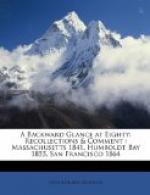That the almost neglected sixties may have some setting, let me briefly trace the beginnings. Things moved slowly when America was discovered. Columbus found the mainland in 1503. Ten years later Balboa reached the Pacific, and, wading into the ocean, modestly claimed for his sovereign all that bordered its shores. Thirty years thereafter the point farthest west was named Mendocino, for Mendoza, the viceroy ordering the expedition of Cabrillo and Ferrelos. Thirty-seven years later came Drake, and almost found San Francisco Bay. But all these discoveries led to no occupation. It seems incredible that two hundred and twenty-six years elapsed from Cabrillo’s visit to the day the first settlers landed in San Diego, founding the first of the famous missions. Historically, 1769 is surely marked. In this year Napoleon and Wellington were born and civilized California was founded.
San Francisco Bay was discovered by a land party. It was August 6, 1775, seven weeks after the battle of Bunker Hill, that Ayala cautiously found his way into the bay and anchored the “San Carlos” off Sausalito. Five days before the Declaration of Independence was signed Moraga and his men, the first colonists, arrived in San Francisco and began getting out the timber to build the fort at the Presidio and the church at Mission Dolores.
Vancouver, in 1792, poking into an unknown harbor, found a good landing-place at a cove around the first point he rounded at his right. The Spaniards called it Yerba Buena, after the fragrant running vine that abounded in the lee of the sandhills which filled the present site of Market Street, especially at a point now occupied by the building of the Mechanics-Mercantile Library. There was no human habitation in sight, nor was there to be for forty years, but friendly welcome came on the trails that led to the Presidio and the Mission.
An occasional whaler or a trader in hides and tallow came and went, but foreigners were not encouraged to settle. It was in 1814 that the first “Gringo” came. In 1820 there were thirteen in all California, three of whom were Americans. In 1835 William A. Richardson was the first foreign resident of Yerba Buena. He was allowed to lay out a street and build a structure of boards and ship’s sails in the Calle de Fundacion, which generally followed the lines of the present Grant Avenue. The spot approximates number 811 of the avenue today. When Dana came in 1835 it was the only house visible. The following year Jacob P. Leese built a complete house, and it was dedicated by a celebration and ball on the Fourth of July in which the whole community participated.




